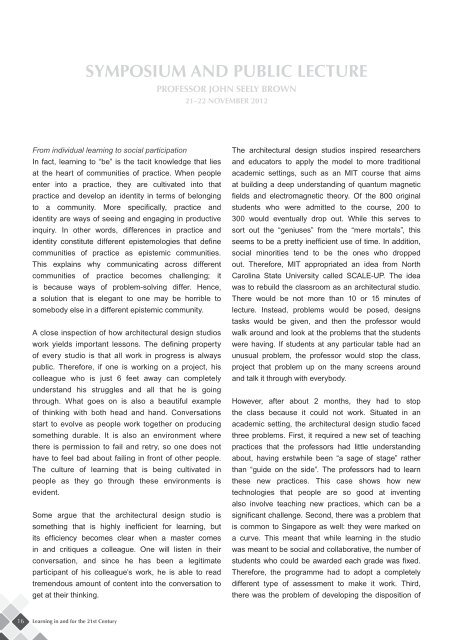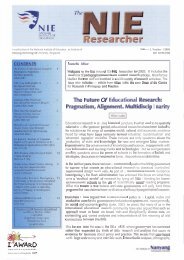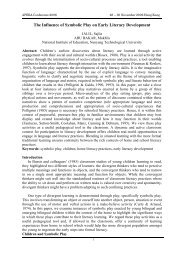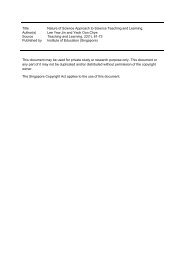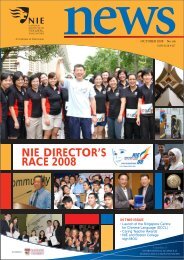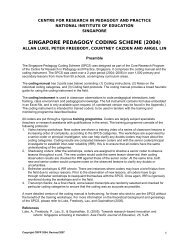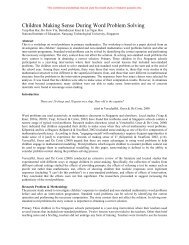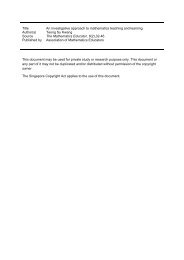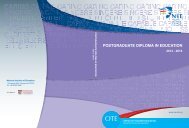Learning in and for the 21st Century - NIE Digital Repository
Learning in and for the 21st Century - NIE Digital Repository
Learning in and for the 21st Century - NIE Digital Repository
You also want an ePaper? Increase the reach of your titles
YUMPU automatically turns print PDFs into web optimized ePapers that Google loves.
SYMPOSIUM <strong>and</strong> PUBLIC LECTURE<br />
Professor JOHN SEELY BROWN<br />
21–22 November 2012<br />
From <strong>in</strong>dividual learn<strong>in</strong>g to social participation<br />
In fact, learn<strong>in</strong>g to “be” is <strong>the</strong> tacit knowledge that lies<br />
at <strong>the</strong> heart of communities of practice. When people<br />
enter <strong>in</strong>to a practice, <strong>the</strong>y are cultivated <strong>in</strong>to that<br />
practice <strong>and</strong> develop an identity <strong>in</strong> terms of belong<strong>in</strong>g<br />
to a community. More specifically, practice <strong>and</strong><br />
identity are ways of see<strong>in</strong>g <strong>and</strong> engag<strong>in</strong>g <strong>in</strong> productive<br />
<strong>in</strong>quiry. In o<strong>the</strong>r words, differences <strong>in</strong> practice <strong>and</strong><br />
identity constitute different epistemologies that def<strong>in</strong>e<br />
communities of practice as epistemic communities.<br />
This expla<strong>in</strong>s why communicat<strong>in</strong>g across different<br />
communities of practice becomes challeng<strong>in</strong>g; it<br />
is because ways of problem-solv<strong>in</strong>g differ. Hence,<br />
a solution that is elegant to one may be horrible to<br />
somebody else <strong>in</strong> a different epistemic community.<br />
A close <strong>in</strong>spection of how architectural design studios<br />
work yields important lessons. The def<strong>in</strong><strong>in</strong>g property<br />
of every studio is that all work <strong>in</strong> progress is always<br />
public. There<strong>for</strong>e, if one is work<strong>in</strong>g on a project, his<br />
colleague who is just 6 feet away can completely<br />
underst<strong>and</strong> his struggles <strong>and</strong> all that he is go<strong>in</strong>g<br />
through. What goes on is also a beautiful example<br />
of th<strong>in</strong>k<strong>in</strong>g with both head <strong>and</strong> h<strong>and</strong>. Conversations<br />
start to evolve as people work toge<strong>the</strong>r on produc<strong>in</strong>g<br />
someth<strong>in</strong>g durable. It is also an environment where<br />
<strong>the</strong>re is permission to fail <strong>and</strong> retry, so one does not<br />
have to feel bad about fail<strong>in</strong>g <strong>in</strong> front of o<strong>the</strong>r people.<br />
The culture of learn<strong>in</strong>g that is be<strong>in</strong>g cultivated <strong>in</strong><br />
people as <strong>the</strong>y go through <strong>the</strong>se environments is<br />
evident.<br />
Some argue that <strong>the</strong> architectural design studio is<br />
someth<strong>in</strong>g that is highly <strong>in</strong>efficient <strong>for</strong> learn<strong>in</strong>g, but<br />
its efficiency becomes clear when a master comes<br />
<strong>in</strong> <strong>and</strong> critiques a colleague. One will listen <strong>in</strong> <strong>the</strong>ir<br />
conversation, <strong>and</strong> s<strong>in</strong>ce he has been a legitimate<br />
participant of his colleague’s work, he is able to read<br />
tremendous amount of content <strong>in</strong>to <strong>the</strong> conversation to<br />
get at <strong>the</strong>ir th<strong>in</strong>k<strong>in</strong>g.<br />
The architectural design studios <strong>in</strong>spired researchers<br />
<strong>and</strong> educators to apply <strong>the</strong> model to more traditional<br />
academic sett<strong>in</strong>gs, such as an MIT course that aims<br />
at build<strong>in</strong>g a deep underst<strong>and</strong><strong>in</strong>g of quantum magnetic<br />
fields <strong>and</strong> electromagnetic <strong>the</strong>ory. Of <strong>the</strong> 800 orig<strong>in</strong>al<br />
students who were admitted to <strong>the</strong> course, 200 to<br />
300 would eventually drop out. While this serves to<br />
sort out <strong>the</strong> “geniuses” from <strong>the</strong> “mere mortals”, this<br />
seems to be a pretty <strong>in</strong>efficient use of time. In addition,<br />
social m<strong>in</strong>orities tend to be <strong>the</strong> ones who dropped<br />
out. There<strong>for</strong>e, MIT appropriated an idea from North<br />
Carol<strong>in</strong>a State University called SCALE-UP. The idea<br />
was to rebuild <strong>the</strong> classroom as an architectural studio.<br />
There would be not more than 10 or 15 m<strong>in</strong>utes of<br />
lecture. Instead, problems would be posed, designs<br />
tasks would be given, <strong>and</strong> <strong>the</strong>n <strong>the</strong> professor would<br />
walk around <strong>and</strong> look at <strong>the</strong> problems that <strong>the</strong> students<br />
were hav<strong>in</strong>g. If students at any particular table had an<br />
unusual problem, <strong>the</strong> professor would stop <strong>the</strong> class,<br />
project that problem up on <strong>the</strong> many screens around<br />
<strong>and</strong> talk it through with everybody.<br />
However, after about 2 months, <strong>the</strong>y had to stop<br />
<strong>the</strong> class because it could not work. Situated <strong>in</strong> an<br />
academic sett<strong>in</strong>g, <strong>the</strong> architectural design studio faced<br />
three problems. First, it required a new set of teach<strong>in</strong>g<br />
practices that <strong>the</strong> professors had little underst<strong>and</strong><strong>in</strong>g<br />
about, hav<strong>in</strong>g erstwhile been “a sage of stage” ra<strong>the</strong>r<br />
than “guide on <strong>the</strong> side”. The professors had to learn<br />
<strong>the</strong>se new practices. This case shows how new<br />
technologies that people are so good at <strong>in</strong>vent<strong>in</strong>g<br />
also <strong>in</strong>volve teach<strong>in</strong>g new practices, which can be a<br />
significant challenge. Second, <strong>the</strong>re was a problem that<br />
is common to S<strong>in</strong>gapore as well: <strong>the</strong>y were marked on<br />
a curve. This meant that while learn<strong>in</strong>g <strong>in</strong> <strong>the</strong> studio<br />
was meant to be social <strong>and</strong> collaborative, <strong>the</strong> number of<br />
students who could be awarded each grade was fixed.<br />
There<strong>for</strong>e, <strong>the</strong> programme had to adopt a completely<br />
different type of assessment to make it work. Third,<br />
<strong>the</strong>re was <strong>the</strong> problem of develop<strong>in</strong>g <strong>the</strong> disposition of<br />
16 <strong>Learn<strong>in</strong>g</strong> <strong>in</strong> <strong>and</strong> <strong>for</strong> <strong>the</strong> <strong>21st</strong> <strong>Century</strong>


